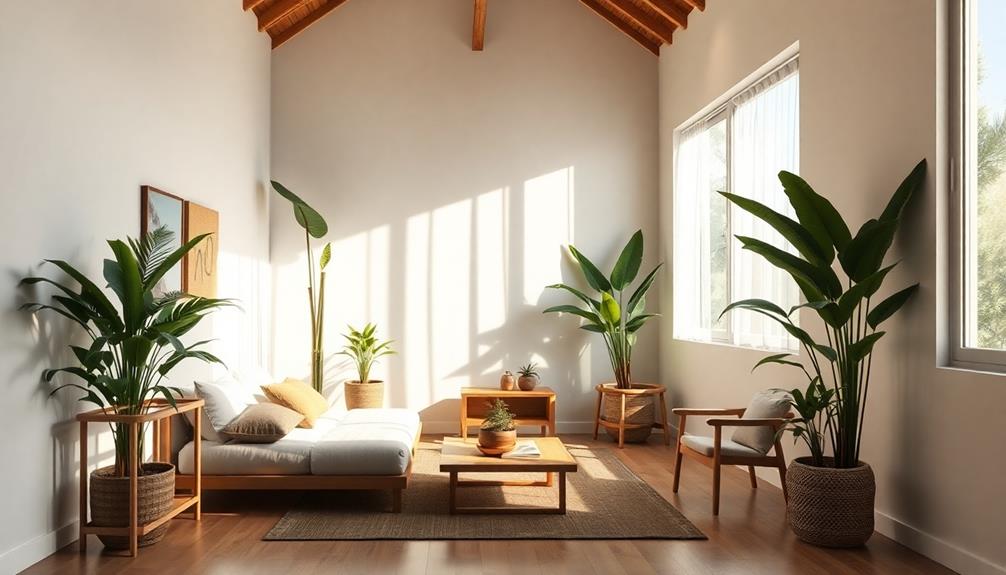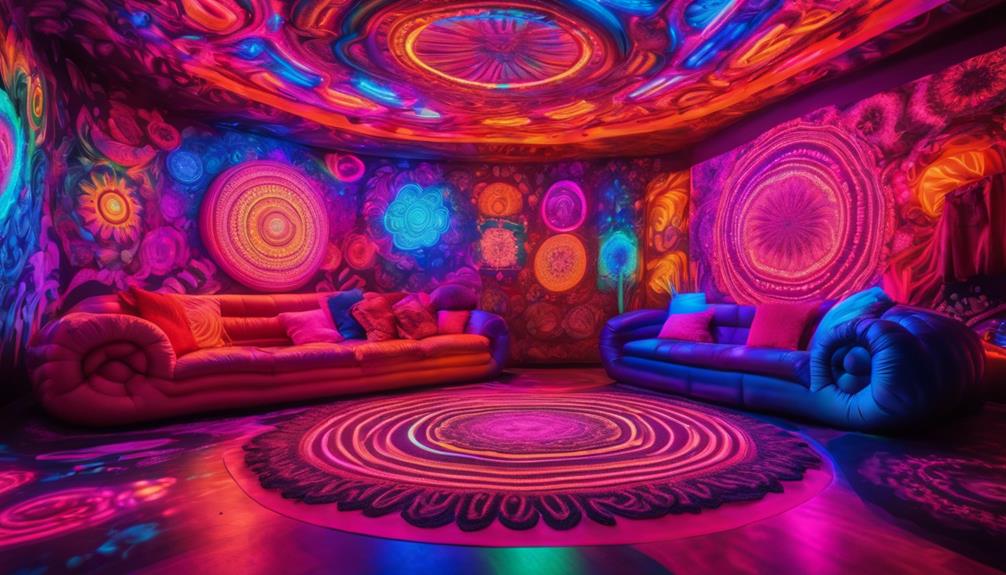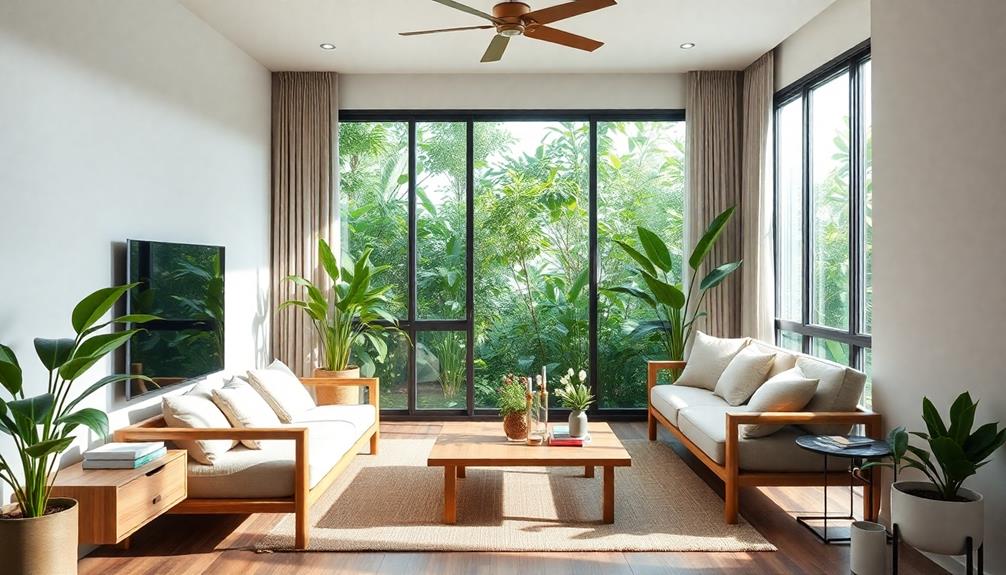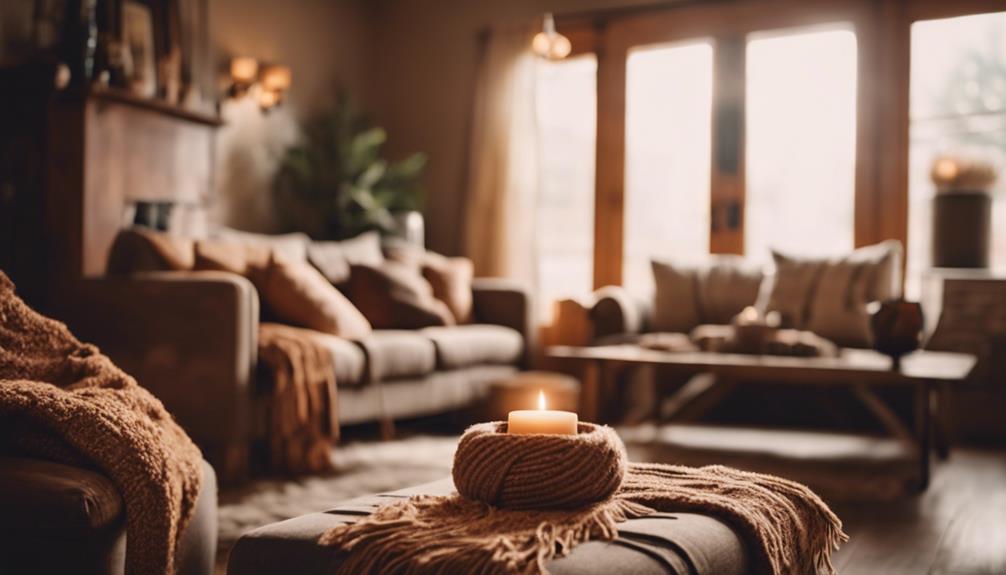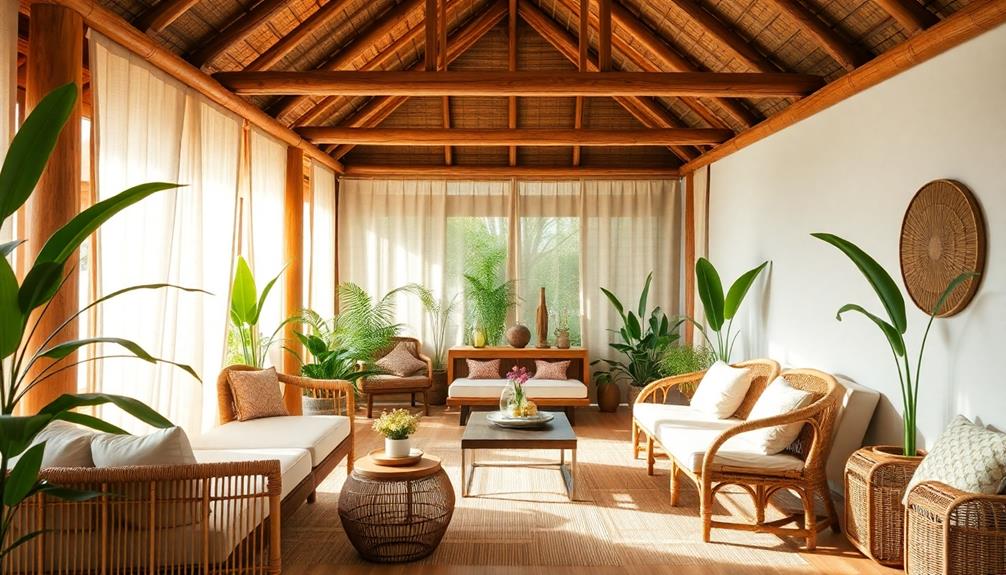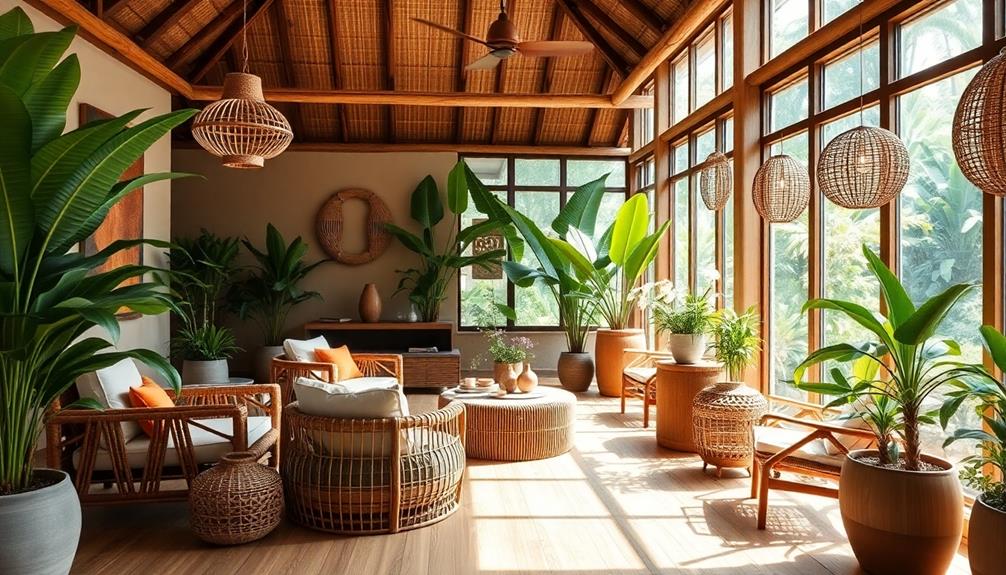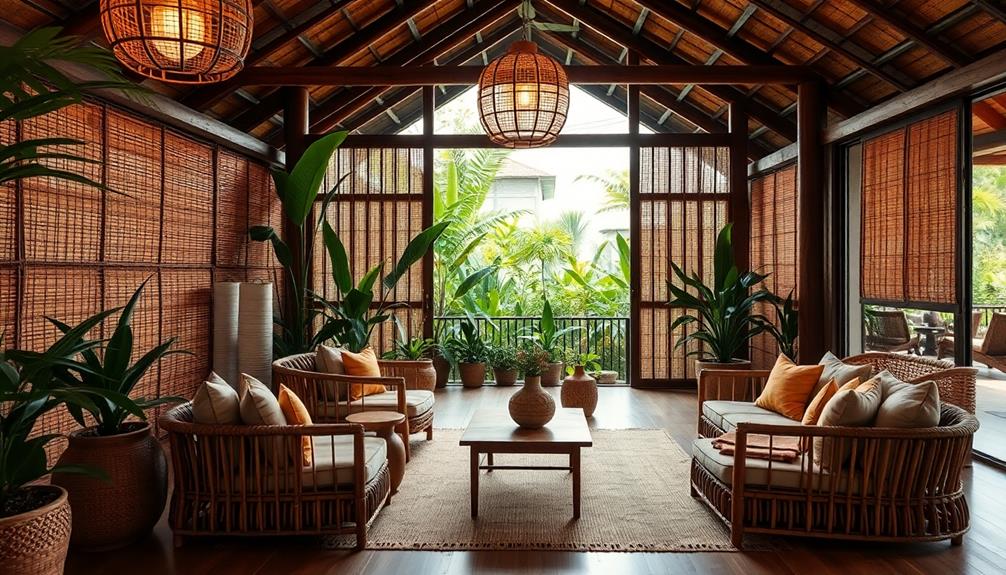You should choose minimalist Indonesian design for small spaces because it blends functionality with cultural elegance effortlessly. The "less is more" philosophy maximizes utility while using natural materials like bamboo and wood, creating warmth and tranquility. This approach not only enhances the space but also integrates eco-friendly practices and smart technology for convenience. By incorporating Balinese motifs and textures, you add visual interest without clutter. Ultimately, minimalist Indonesian design transforms your limited area into a stylish and harmonious retreat. Discover how to create your own serene sanctuary with these principles and techniques worth exploring further.
Key Takeaways
- Minimalist Indonesian design maximizes utility in small spaces through its "less is more" philosophy, promoting functionality and efficiency.
- Natural materials like bamboo and rattan create warmth and texture, enhancing comfort in compact environments.
- The integration of cultural elements, such as Balinese motifs, adds aesthetic richness while maintaining simplicity.
- Sustainable practices and eco-friendly materials contribute to a harmonious living environment, reducing environmental impact.
- Smart technology enhances convenience, streamlining home functions while preserving clean and organized spaces.
The Essence of Minimalism
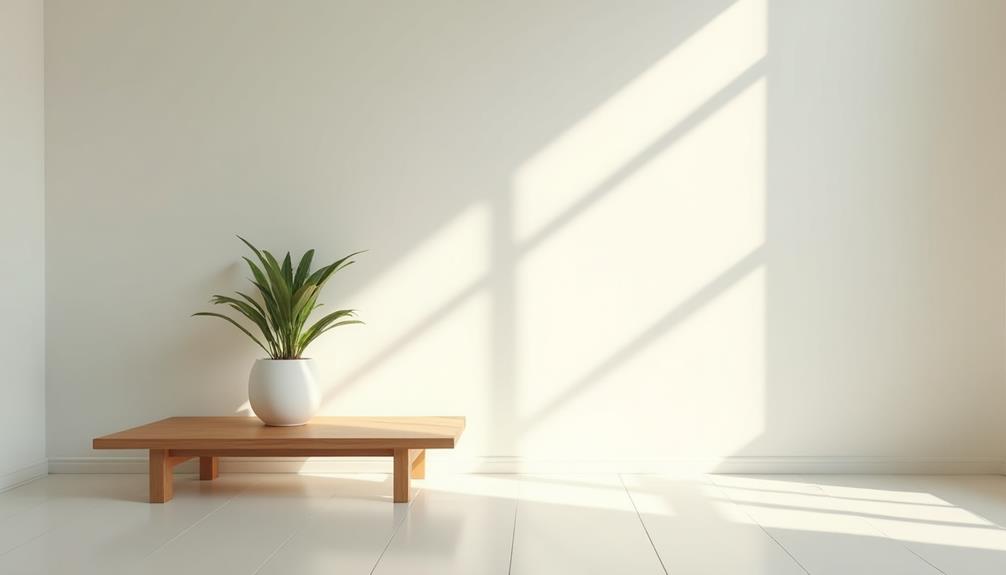
When it comes to minimalist Indonesian design, simplicity and functionality go hand in hand. This design philosophy embodies the "less is more" approach, allowing you to maximize the utility of small spaces. By embracing minimalist principles, you create an environment that feels open and uncluttered.
Traditional Indonesian aesthetics, like Balinese motifs and Javanese batik patterns, can still enrich your space, adding visual interest without overwhelming it. Additionally, the emphasis on natural materials like wood, stone, and bamboo provides a warm and inviting atmosphere that complements the minimalist ethos.
Using eco-friendly materials such as bamboo and rattan not only promotes sustainability but also enhances the aesthetic of your minimalist interior. These materials are lightweight yet sturdy, perfect for compact living.
You'll often find open layouts and large windows in minimalist Indonesian designs, which create a sense of spaciousness that's essential for smaller homes.
Moreover, integrating smart home technology enhances the functionality of your space, offering convenience while maintaining a clean look. By focusing on what truly matters, you can design a home that reflects your values and lifestyle while ensuring your living area remains practical and inviting.
Embracing minimalist Indonesian design means you're not just creating a home; you're curating an experience of tranquility and efficiency.
Cultural Influence on Design
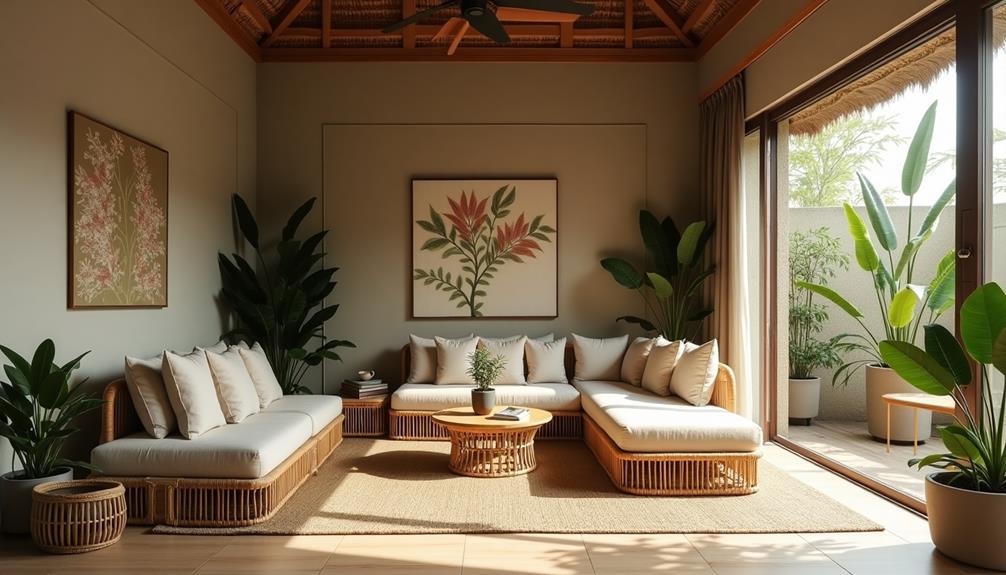
Cultural influences play a pivotal role in shaping minimalist Indonesian design, blending traditional aesthetics with contemporary principles to create unique living spaces.
You'll find that this design style utilizes Balinese motifs and Javanese batik patterns, celebrating Indonesia's rich heritage while adhering to minimalist ideals. The focus on natural materials like bamboo and rattan not only reflects regional diversity but also promotes sustainability and eco-friendliness.
Additionally, incorporating elements like Indonesian decorative pillows enhances comfort while showcasing vibrant cultural patterns, further enriching the minimalist approach.
Here are three key aspects of cultural influence in minimalist design:
- Local Customs: Indonesian designers often draw inspiration from local customs, resulting in interiors that resonate with cultural heritage.
- Philosophical Foundations: The emphasis on harmony and tranquility reflects cultural philosophies prioritizing simplicity and the beauty of emptiness.
- Global Recognition: Many Indonesian design firms gain international acclaim, showcasing how cultural influence shapes modern spaces that appeal to both local and global audiences.
Benefits of Minimalist Spaces
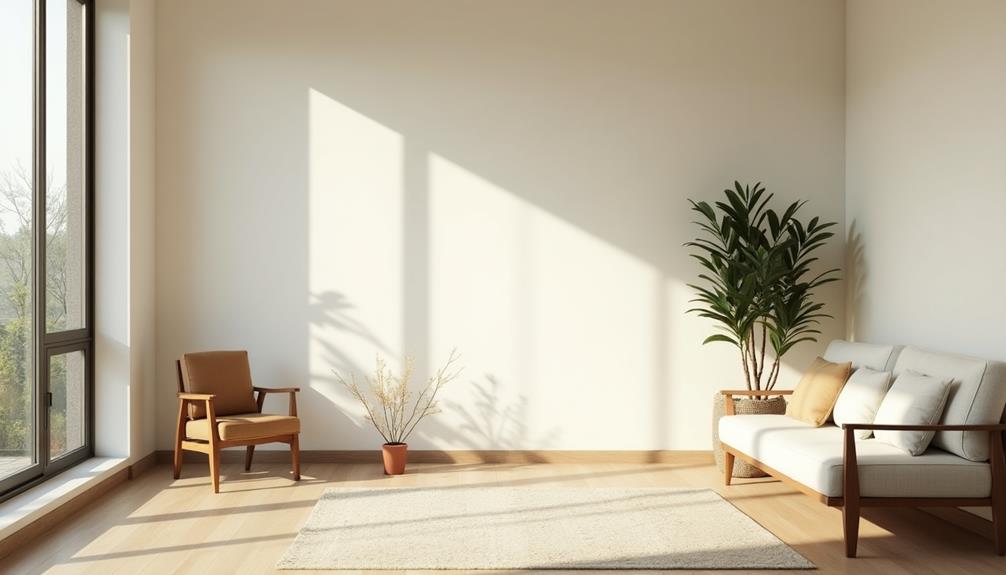
Minimalist spaces offer a range of benefits that enhance both functionality and well-being, especially in small living areas. By incorporating elements of traditional artistry, such as Indonesian decor masks, you create a serene environment that can alleviate stress and anxiety, making your home feel more peaceful.
Minimalist interiors focus on clean lines and simplicity, allowing you to use limited space efficiently. This design approach maximizes your small rooms, enhancing their overall utility.
With the incorporation of natural materials and neutral color palettes, minimalist design fosters a sense of openness, making your space feel larger and more inviting. You'll find that emphasizing smart organization helps you make the most of every inch available, minimizing the need for excessive furniture and decor.
Adopting a quality-over-quantity mindset encourages you to choose fewer but more meaningful possessions. This shift can greatly enhance your personal well-being, particularly in confined environments.
Ultimately, minimalist spaces aren't just about aesthetics; they reflect a lifestyle that values tranquility, functionality, and intentional living. So, if you're seeking a better way to experience your small space, embracing minimalist Indonesian design may be the perfect solution.
Sustainable Design Practices

When you explore minimalist Indonesian design, you'll notice a strong emphasis on sustainable practices. This design approach often incorporates natural materials like wood and stone, which resonate with the local culture and promote harmony with nature.
Designers often use eco-friendly materials like bamboo and rattan, which not only reduce environmental impact but also add unique charm to small spaces. Plus, energy-efficient solutions, such as natural ventilation, help keep your home comfortable while minimizing energy consumption.
Traditional Indonesian Style Home Decor enhances the overall ambiance and aesthetic appeal of these thoughtfully designed environments.
Eco-Friendly Materials
The heart of eco-friendly materials in Indonesian design lies in their sustainable nature, which not only benefits the environment but also enriches your living space.
By choosing minimalist furniture made from these materials, you create a harmonious atmosphere that reflects your commitment to sustainability. Incorporating elements such as traditional craftsmanship not only enhances the aesthetic qualities but also adds depth to your design narrative.
Here are three key eco-friendly materials commonly used in minimalist Indonesian design:
- Bamboo: This fast-growing plant is abundant in the region, making it a fantastic choice for furniture and decor. It's strong, lightweight, and naturally resilient.
- Rattan: Known for its flexibility and durability, rattan is perfect for crafting beautiful minimalist furniture. It supports local artisans and promotes environmentally responsible practices.
- Reclaimed wood: Utilizing reclaimed wood not only reduces waste but also adds character to your space. It's a demonstration of sustainable design and offers unique textures and stories.
Incorporating these eco-friendly materials into your home not only enhances its aesthetic appeal but also supports local communities and reduces environmental impact.
Embrace the beauty of minimalist Indonesian design and make a positive statement in your small space.
Energy Efficiency Solutions
Creating an energy-efficient home not only cuts down on utility bills but also enhances your comfort in small spaces. Traditional Indonesian housing often incorporates natural ventilation, which allows for air flow and minimizes reliance on mechanical cooling systems; this design principle can be applied to modern minimalist spaces as well.
You can start by incorporating energy-efficient lighting solutions, like LED bulbs, which greatly reduce energy consumption. Natural ventilation is another key element; strategically placed windows and openings allow fresh air to flow, minimizing your reliance on air conditioning and keeping your space comfortable.
Using eco-friendly materials, such as bamboo and reclaimed wood, is essential too. These materials support sustainability while improving thermal performance in your home, reflecting the regional identity found in traditional Indonesian housing.
When it comes to appliances, opt for energy-efficient models designed to use less electricity and water. This choice not only lowers your bills but also contributes to a more sustainable living environment.
Don't forget to integrate smart home technology, like programmable thermostats and energy monitoring systems. These tools give you greater control over your energy usage, ensuring your minimalist design remains efficient.
Space-Efficient Furniture Solutions
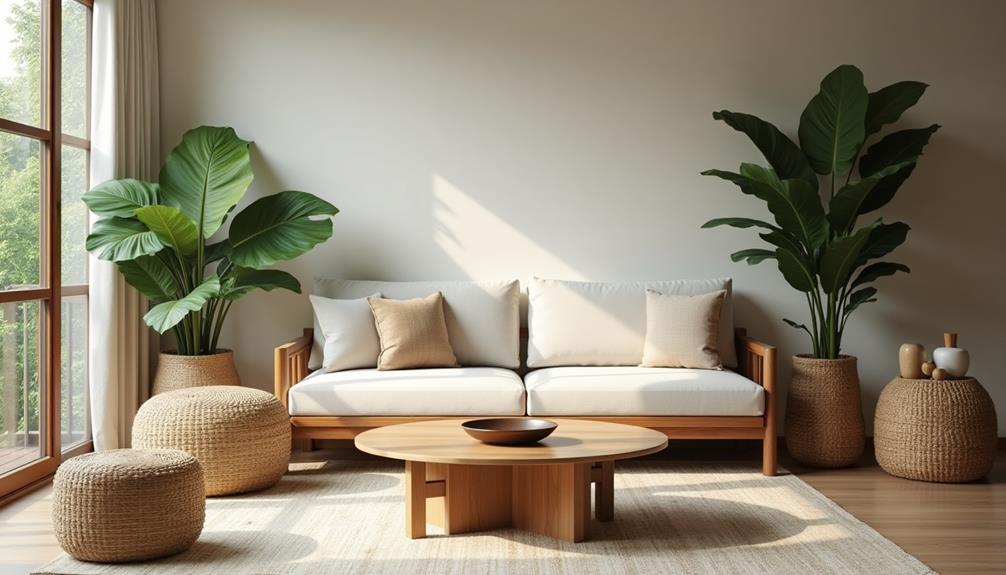
In small spaces, selecting space-efficient furniture solutions can transform your living area into a functional haven. Minimalist Indonesian design excels in this area, offering innovative pieces that maximize utility without sacrificing style.
By choosing furniture that serves multiple purposes, you can make the most of every square inch. Many shops in Bali, like Mahallati Interiors, specialize in custom solutions that harmonize with minimalist aesthetics while integrating natural materials.
Here are three space-efficient furniture solutions to contemplate:
- Convertible Sofas: Opt for sofas that transform into beds, providing a cozy spot for guests without taking up extra space.
- Ottomans with Storage: Look for ottomans that have hidden compartments, perfect for stashing away blankets or magazines, keeping your minimalist interior clutter-free.
- Custom-Built Shelving: Reflect on built-in shelving or wall-mounted units tailored to your space, enhancing both function and aesthetics while maintaining an open floor area.
These solutions not only promote an eco-friendly approach with materials like bamboo and rattan but also create a sleek, low-profile design that makes your small area feel larger.
Embrace these space-efficient furniture solutions, and watch your compact living space flourish into a beautifully organized environment.
Integrating Natural Elements

Integrating natural elements into your small space not only enhances its beauty but also fosters a calming environment. By incorporating materials like bamboo and rattan, you're embracing a minimalist style that's eco-friendly and sustainable. These materials are perfect for small spaces, adding texture and warmth without overwhelming the area.
Consider bringing the outdoors in with indoor gardens or strategically placed plants. They not only improve air quality but also create a sense of tranquility, making your small area feel expansive. Large windows and open layouts are essential in this design approach, allowing natural light to flood your space and connect it seamlessly with the outdoors.
Here's a quick reference table to help you visualize these ideas:
| Element | Benefits |
|---|---|
| Bamboo & Rattan | Sustainable, adds warmth |
| Indoor Gardens | Enhances air quality, tranquility |
| Natural Light | Expands feel, connects to nature |
| Textures (Wood/Stone) | Adds depth, inviting atmosphere |
Smart Technology in Design
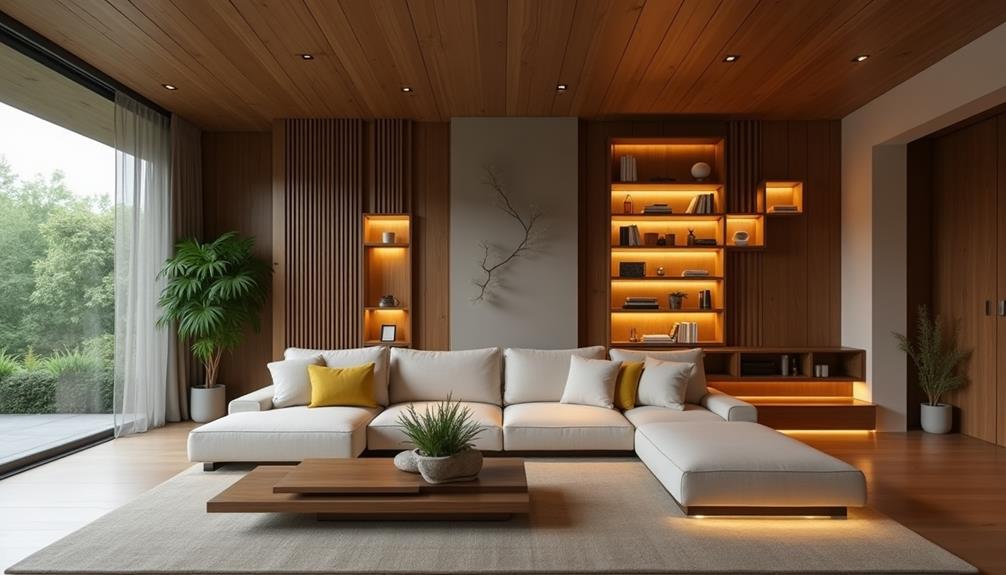
As you embrace natural elements in your small space, consider the role of smart technology in enhancing efficiency and functionality.
Integrating smart devices into your minimalist Indonesian design not only elevates convenience but also aligns with modern design principles. By focusing on Tropical Villa Plans, you can guarantee that your small space is both aesthetically pleasing and functional.
Here are three ways smart technology can transform your living area:
- Automated Systems: Use smart lighting and climate control to adapt your environment with ease, guaranteeing comfort without cluttering your space.
- Multi-functional Furniture: Invest in smart furniture like convertible sofas and extendable tables, allowing versatility without compromising on your minimalist aesthetic.
- IoT Integration: Embrace Internet of Things devices to control your home remotely, streamlining your living experience while maintaining an uncluttered look.
Balancing Aesthetics and Functionality
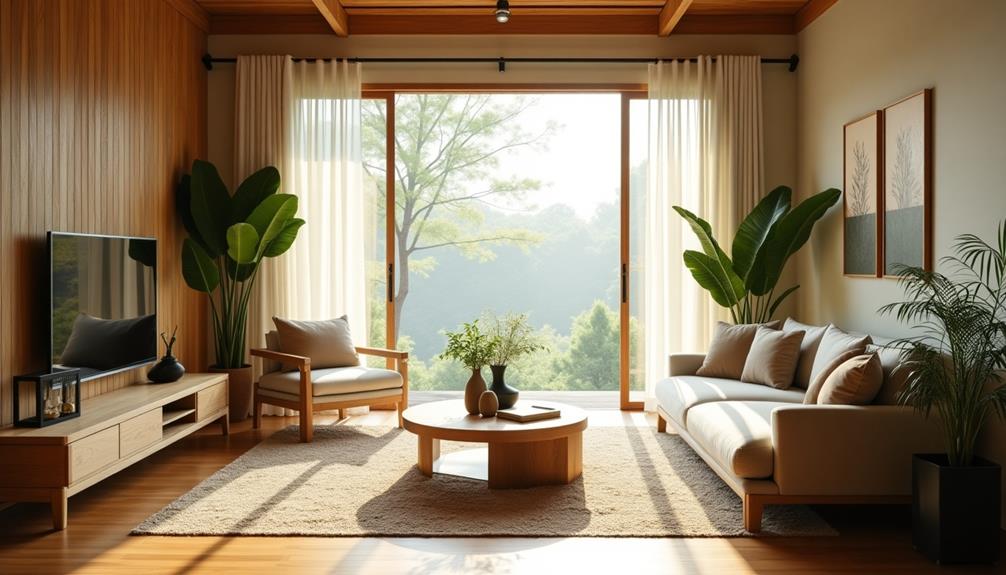
In minimalist Indonesian design, you'll find a perfect blend of aesthetics and functionality that transforms small spaces.
This style emphasizes the use of natural materials like wood and stone, creating a seamless connection with the surrounding environment.
By incorporating modern tropical aesthetics, you create a harmonious environment that feels open and inviting.
This approach not only maximizes space but also enhances the overall visual appeal of your home.
Harmonious Space Utilization
Embracing the principles of minimalist Indonesian design can transform small spaces into harmonious havens that balance aesthetics and functionality.
By focusing on harmonious space utilization, you can create a serene environment that feels inviting and spacious. Incorporating elements from luxury tropical designs can further enhance the overall ambiance of your space.
Here are three key strategies to contemplate:
- Multifunctional Furniture: Opt for pieces that serve multiple purposes, like a coffee table that doubles as storage. This keeps your Minimalist Living Room organized and stylish.
- Natural Light and Open Layouts: Incorporate large windows and maintain an open layout to enhance ventilation and natural light. This airy atmosphere not only makes the space feel larger but also uplifts your mood.
- Cultural Elements: Integrate traditional Balinese motifs or Javanese batik patterns in your decor. These elements enhance aesthetic appeal without overwhelming your space, creating a perfect balance.
Natural Material Emphasis
To create a truly harmonious small space, focusing on natural materials is key. Minimalist Indonesian design often incorporates sustainable options like bamboo and rattan. These materials aren't only lightweight but also environmentally friendly, making them perfect for small spaces. By using these elements, you enhance the aesthetic appeal of your home while guaranteeing functionality.
Natural textures, such as wooden furniture and stone accents, add visual interest without overwhelming your space. They provide durability and a timeless quality, perfectly aligning with minimalist principles. The warmth of these materials creates an inviting atmosphere, which is essential for small living areas where every detail counts.
Moreover, choosing locally sourced natural materials supports regional craftsmanship and promotes cultural heritage. This connection to your surroundings can make your small space feel unique and deeply personal.
Emphasizing natural materials allows you to achieve a serene and uncluttered environment, ideal for relaxation and creativity. Incorporating these elements not only beautifies your home but also guarantees it remains practical.
Clean Lines Design
Clean lines in minimalist Indonesian design provide a perfect balance between aesthetics and functionality, creating a space that's both visually appealing and practical.
By emphasizing simplicity and elegance, these designs maximize the perception of space in smaller areas, making them ideal for your home.
Here are three key benefits of clean lines in your spaces:
- Enhanced Flow: Straight edges and geometric shapes promote efficient furniture arrangements, allowing for easy movement throughout your area.
- Natural Light: Large windows and open layouts connect indoor spaces with nature, flooding your home with sunlight and creating an airy ambiance.
- Tranquility: A focus on decluttering within a clean-lined framework reduces visual noise, fostering a serene living environment that feels spacious and inviting.
Incorporating natural materials like bamboo and rattan aligns with clean lines, adding warmth while maintaining an organized aesthetic.
This design approach not only elevates your space but also guarantees that every element serves a purpose.
Embrace minimalist Indonesian design, and transform your small spaces into harmonious, functional retreats that reflect your style.
Future Trends in Indonesian Design
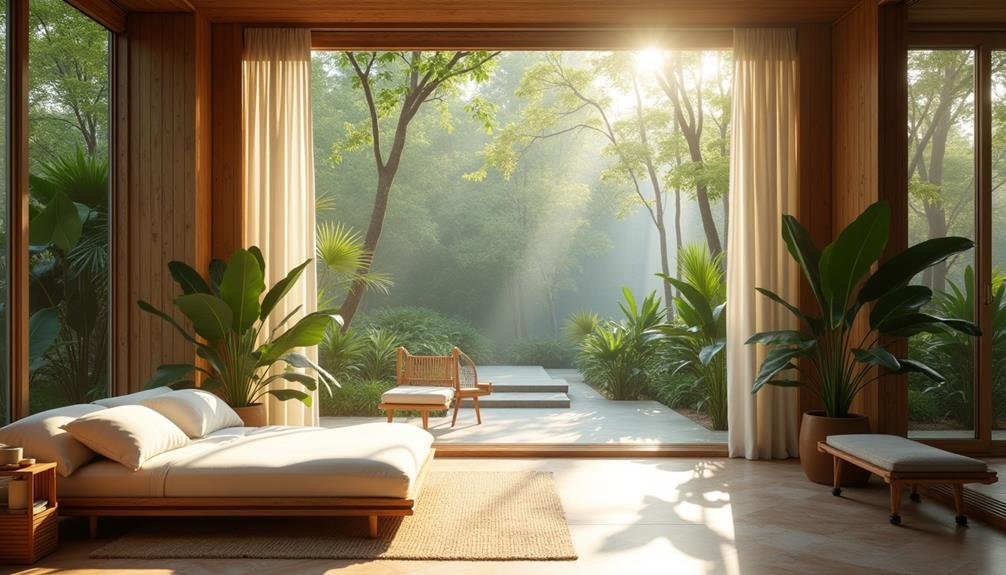
The future of Indonesian design is poised for transformation, driven by a blend of sustainability and technology. You can expect to see a significant shift towards sustainable practices, with designers prioritizing eco-friendly materials and energy-efficient solutions. This aligns perfectly with global sustainability trends, making your living spaces not only stylish but also responsible.
As smart home technology continues to evolve, Indonesian designers are likely to integrate automated systems into their projects, enhancing convenience and energy management in your home.
Furthermore, a growing emphasis on cultural preservation will bring traditional Indonesian aesthetics into the modern minimalist framework. This fusion will create unique, meaningful environments that celebrate heritage while meeting contemporary needs.
The rise of digital design platforms will revolutionize the industry, providing you with greater access to creative tools and fostering collaboration among designers. This environment will enhance the quality of design, making it more innovative and relevant.
Additionally, increased investment in interior design education will nurture local talent, equipping future designers to tackle the challenges of this evolving market. Embracing these trends won't only elevate your space but also contribute to a more sustainable and culturally rich future in Indonesian design.
Frequently Asked Questions
Why Do You Choose Minimalist Design?
You choose minimalist design because it creates a serene, organized space. It emphasizes functionality and simplicity, allowing your environment to breathe. By reducing clutter, you cultivate a calm atmosphere that enhances your daily living experience.
What Is the Purpose of Minimalist Architecture?
Minimalist architecture serves to simplify your living space, reducing clutter and enhancing tranquility. It emphasizes natural light and open areas, allowing you to connect with nature while creating a functional, adaptable environment that promotes well-being.
Why Do People Like Minimalist Decor?
You walk into a serene space, where each element breathes simplicity. People love minimalist decor for its calming effect, functional elegance, and the beauty of fewer, well-chosen pieces that create harmony and clarity in their lives.
What Are the 5 Most Important Features of Minimalist Architecture?
The five most important features of minimalist architecture are clean lines, open spaces, neutral color palettes, natural light maximization, and the use of sustainable materials. These elements create harmony, simplicity, and functionality in your environment.
Conclusion
Choosing minimalist Indonesian design for your small space isn't just about aesthetics; it's a lifestyle choice that resonates with simplicity and harmony. You'll find that every piece serves a purpose, creating an environment that feels open and inviting. Imagine walking into a room that seamlessly blends function with beauty, where natural elements breathe life into your home. As trends evolve, embracing this design philosophy could very well transform your space into a sanctuary of peace and efficiency.
